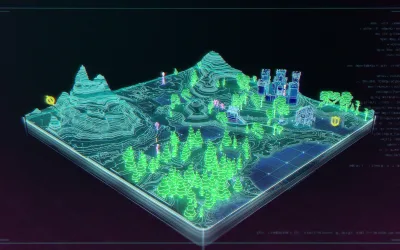Daniel Steinholtz |
April 3, 2024
Game Developer Conference 2024 happened, and we were there! Here’s what the game community thought about Lemur, our upcoming multiplayer development platform.
March was a busy month for Ringtail Interactive. Not only did we celebrate the company moving into our new office, but we also decided to open the curtains (albeit slightly) on our flagship multiplayer development platform – also known as Lemur – after being in stealth mode development for more than six years.
The first version of the Lemur website went live and while it’s still early days, hopefully it gives a first idea of the genuinely game-changing innovations of our upcoming platform.
Take a look at our freshly-baked trailer:
The trailer was made to be shown at the Game Developers Conference (also known as GDC), which is held yearly in San Francisco – the games industry’s premier professional event. There were three of us in attendance from Ringtail; the journey began in the Nordic chill of Stockholm and ended in the mild warmth of California’s famed Bay Area.
And here we are!

From left to right: Joakim Reimer, Brand Manager; Bastian Geissler, CEO; and Daniel Steinholtz, PR Lead.
Yerba Buena Gardens was especially warm and welcoming that day, as you can see! This is also one of the main congregation areas outside of the Moscone Center (where the actual conference was held), just a short walk from Union Square.
Now, despite the huge expo floor and many, many interesting introductions, sessions, and conversations inside Moscone, the real meat of GDC actually happens outside of the venue. In above mentioned Yerba Buena Gardens, but also in hotel lobbies (particularly the Marriott Marquis lobby – whew!), cafés, mixers, etc.
Networking with wonderful games industry peers was high on our list, but our primary goal was to start introducing “Lemur” into the game development vernacular. We wanted to receive as much feedback as possible and see how the pitch resonated with the community.
We engaged everyone, from indie developers and publishers to game students, senior industry professionals, education clusters, and consultants specialized in the backend; the consensus was:
“It sounds too good to be true!”
We listened to countless stories about seasoned teams struggling with their multiplayer components and stories about innumerable student projects that were nixed due to high complexity. Then, stories about the cost and the stress of implementing a networking infrastructure, and all that entails.
The concept of developing a multiplayer game with the simplicity of single-player was, to say the least, intriguing to those we talked to – and, as expected, many didn’t believe us. They wanted to see proof.
Totally understandable – I’d want the same! So, what did we learn?
- Our own belief in Lemur’s ability to be a game-changing platform for multiplayer development was validated by those we talked to. The excitement was tangible.
- We need to deliver proof because, as they say, “seeing is believing.” Devs want to play around with the SDK for themselves.
- We still have a ways to go before releasing Lemur into the wild, but we’re going to gradually start delivering those essential samples in the coming months. Stay tuned!
- There’s great potential for Lemur in both the professional and educational space. In the long term, we’ll investigate how we can best support up-and-coming game creators. After all, Lemur’s core belief is leveling the playing field between AAA and smaller studios – even solo developers.
The incredible energy and renewed motivation coupled with the connections we made with new and familiar industry folks have been lingering on our minds since returning to Stockholm. We are so incredibly excited to show what we’ve got in store for the rest of the year – and for the years to come.


